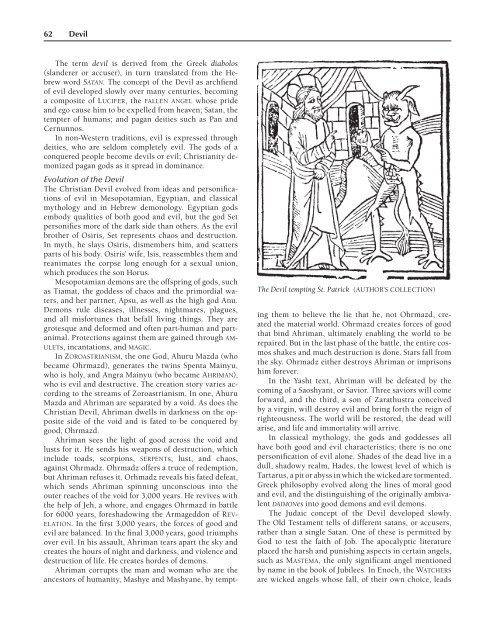The Encyclopedia Of Demons And Demonology
The Encyclopedia Of Demons And Demonology
The Encyclopedia Of Demons And Demonology
Create successful ePaper yourself
Turn your PDF publications into a flip-book with our unique Google optimized e-Paper software.
62 Devil<br />
<strong>The</strong> Devil tempting St. Patrick (AUTHOR’S COLLECTION)<br />
<strong>The</strong> term devil is derived from the Greek diabolos<br />
(slanderer or accuser), in turn translated from the Hebrew<br />
word SATAN. <strong>The</strong> concept of the Devil as archfiend<br />
of evil developed slowly over many centuries, becoming<br />
a composite of LUCIFER, the FALLEN ANGEL whose pride<br />
and ego cause him to be expelled from heaven; Satan, the<br />
tempter of humans; and pagan deities such as Pan and<br />
Cernunnos.<br />
In non-Western traditions, evil is expressed through<br />
deities, who are seldom completely evil. <strong>The</strong> gods of a<br />
conquered people become devils or evil; Christianity demonized<br />
pagan gods as it spread in dominance.<br />
Evolution of the Devil<br />
<strong>The</strong> Christian Devil evolved from ideas and personifications<br />
of evil in Mesopotamian, Egyptian, and classical<br />
mythology and in Hebrew demonology. Egyptian gods<br />
embody qualities of both good and evil, but the god Set<br />
personifies more of the dark side than others. As the evil<br />
brother of Osiris, Set represents chaos and destruction.<br />
In myth, he slays Osiris, dismembers him, and scatters<br />
parts of his body. Osiris’ wife, Isis, reassembles them and<br />
reanimates the corpse long enough for a sexual union,<br />
which produces the son Horus.<br />
Mesopotamian demons are the offspring of gods, such<br />
as Tiamat, the goddess of chaos and the primordial waters,<br />
and her partner, Apsu, as well as the high god Anu.<br />
<strong>Demons</strong> rule diseases, illnesses, nightmares, plagues,<br />
and all misfortunes that befall living things. <strong>The</strong>y are<br />
grotesque and deformed and often part-human and partanimal.<br />
Protections against them are gained through AM-<br />
ULETs, incantations, and MAGIC.<br />
In ZOROASTRIANISM, the one God, Ahuru Mazda (who<br />
became Ohrmazd), generates the twins Spenta Mainyu,<br />
who is holy, and Angra Mainyu (who became AHRIMAN),<br />
who is evil and destructive. <strong>The</strong> creation story varies according<br />
to the streams of Zoroastrianism. In one, Ahuru<br />
Mazda and Ahriman are separated by a void. As does the<br />
Christian Devil, Ahriman dwells in darkness on the opposite<br />
side of the void and is fated to be conquered by<br />
good, Ohrmazd.<br />
Ahriman sees the light of good across the void and<br />
lusts for it. He sends his weapons of destruction, which<br />
include toads, scorpions, SERPENTs, lust, and chaos,<br />
against Ohrmadz. Ohrmadz offers a truce of redemption,<br />
but Ahriman refuses it. Orhmadz reveals his fated defeat,<br />
which sends Ahriman spinning unconscious into the<br />
outer reaches of the void for 3,000 years. He revives with<br />
the help of Jeh, a whore, and engages Ohrmazd in battle<br />
for 6000 years, foreshadowing the Armageddon of REV-<br />
ELATION. In the first 3,000 years, the forces of good and<br />
evil are balanced. In the final 3,000 years, good triumphs<br />
over evil. In his assault, Ahriman tears apart the sky and<br />
creates the hours of night and darkness, and violence and<br />
destruction of life. He creates hordes of demons.<br />
Ahriman corrupts the man and woman who are the<br />
ancestors of humanity, Mashye and Mashyane, by tempting<br />
them to believe the lie that he, not Ohrmazd, created<br />
the material world. Ohrmazd creates forces of good<br />
that bind Ahriman, ultimately enabling the world to be<br />
repaired. But in the last phase of the battle, the entire cosmos<br />
shakes and much destruction is done. Stars fall from<br />
the sky. Ohrmadz either destroys Ahriman or imprisons<br />
him forever.<br />
In the Yasht text, Ahriman will be defeated by the<br />
coming of a Saoshyant, or Savior. Three saviors will come<br />
forward, and the third, a son of Zarathustra conceived<br />
by a virgin, will destroy evil and bring forth the reign of<br />
righteousness. <strong>The</strong> world will be restored, the dead will<br />
arise, and life and immortality will arrive.<br />
In classical mythology, the gods and goddesses all<br />
have both good and evil characteristics; there is no one<br />
personification of evil alone. Shades of the dead live in a<br />
dull, shadowy realm, Hades, the lowest level of which is<br />
Tartarus, a pit or abyss in which the wicked are tormented.<br />
Greek philosophy evolved along the lines of moral good<br />
and evil, and the distinguishing of the originally ambivalent<br />
DAIMONes into good demons and evil demons.<br />
<strong>The</strong> Judaic concept of the Devil developed slowly.<br />
<strong>The</strong> Old Testament tells of different satans, or accusers,<br />
rather than a single Satan. One of these is permitted by<br />
God to test the faith of Job. <strong>The</strong> apocalyptic literature<br />
placed the harsh and punishing aspects in certain angels,<br />
such as MASTEMA, the only significant angel mentioned<br />
by name in the book of Jubilees. In Enoch, the WATCHERS<br />
are wicked angels whose fall, of their own choice, leads












